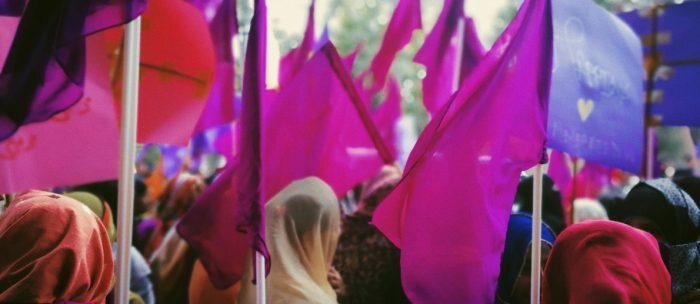
Smartphones and the fight against sexual harassment
The smartphone’s role as a whistle-blower on society is probably least available to those experiencing the heaviest brunt of social injustices.
A few years ago, there was a moment in India, when a Kerala-based excise commissioner, suggested that men who stare at women for longer than 14 seconds should face jail time. He was ridiculed mercilessly for this proposition.
Pakistan’s workplace anti-harassment laws do not include ‘staring at women’ as harassment, though some private workplaces do recognize it as a ‘menace’ in their code of conduct. My workplace in Karachi is not one of them.
One April morning, as I sat on work desk, finishing a report, I felt like I was being watched. Looking over my shoulder, I saw a group of eight men, to my right, sitting only 4 feet away from me, pointedly staring at me. Others were filtering in and out of the room, none of them registering this herd of voyeurs.
One would think that after 20 years of being stared at, I should be immune to the ogling. But take any woman into your confidence and she will tell you that you will always be viscerally aware of men’s stares, regardless of your age. Some people would recommend removing yourself from the situation. As a woman, it is you who are at fault, for being present in the same domain as the men. But even as you leave, the looks linger. I know this because I have left many times.
I decided to record a group of men staring at me, inside my place of work. I directed my small but powerful camera lens towards them, and pressed the red circle on my screen.
On this day, however, I wanted to stay and own the space I was taking up in my own workplace. I tried to stare them down. Perhaps because they outnumbered me, they were not deterred in the slightest. Some were laughing while staring at me. I did not want to set a precedent of being a passive consequence to their lechery, so I decided to record them.
I directed my smart phone, and its small but powerful camera lens towards them, and pressed the red circle on my screen. As moments passed, their smiles faltered. One of them worriedly whispered something to the man beside him, concern spreading across their faces, transferring from one man to the next. One by one their smirks disappeared and their eyes began darting around the room. They wanted the camera to capture that they weren’t staring at me.
Eight men, who physically and socially outweigh my existence, had been disarmed by a smartphone camera.
They were right to be afraid. After all, I could have uploaded the video to social media. It’s on social media that the #MeToo movement found its wings. It’s on social media that Eric Garner’s brutal murder at the hands of the police was exposed, resulting in rallies and protests around #BlackLivesMatter, a US-based social justice movement deeply rooted in feminism. It’s on social media where accusations of Ali Zafar being a harasser unfolded. It’s on social media that screenshots of lewd texts from the CEO of Patari, Khalid Bajwa, spread like wildfire, resulting in a mass exodus of their senior employees in solidarity with the victims.
Is that it then? Have we found the answer to reporting sexual harassment? Not quite, patriarchy isn’t that simple to dismantle.
Firstly, smart phone usage is a privilege. Pakistan suffers a gaping gender gap when it comes to usage, meaning women are far less likely to carry phones than men. The gap is made wider by gaps in literacy and economic and social independence. The smartphone’s role as a whistle-blower on the insidious aspects of society is least available to those possibly experiencing the heaviest brunt of social injustices. Plus, recordings often do not hold up in courts of law, are dismissed as doctored by social media spectators, or find themselves deleted.
And yet, the smart phone’s ability to record and share your experiences has exposed numerous incidents of racism, police brutality, extrajudicial killings (including the Sahiwal incident), and sexism, casual or otherwise.
By using the smartphone camera, women can turn the focus on the perpetrator instead of themselves.
At the end of last year, Nighat Dad, lawyer, activist and the founder of Digital Rights Foundation, recorded and shared a violation she experienced while on a business trip from Doha to Lahore. The video, uploaded on twitter, details a man engaging in public indecency, a narrow airplane seat away from her. And yet many in the comments rush to defend the man. Maybe he was just “scratching” himself? Maybe instead of “infringing on his privacy” Dad should have inquired after his health. Even in a case where there is evidence on camera, the onus of the man’s ailments landed on the woman. Others feigned innocence for the transgressor and demeaned Dad for her “corrupt” thinking.
Even in a case where there is evidence on camera, the onus of the man’s ailments landed on the woman. Others feigned innocence for the transgressor and demeaned Dad for her “corrupt” thinking.
“Even before the plane took off, this man, whose identity I purposefully obscured, began to touch himself. He was pulling at his clothes, ‘fixing’ his groin and crotch, all the while staring at me,” said Dad. One of the complicated hoops Dad – and other women who have attempted to ‘record proof’– jumped through was having to focus, through her screen, on something she clearly did not want to see. Plus, Dad had to use her phone on the sly since she didn’t want the perpetrator to feel encouraged by her in any way.
“My hands were shaking because of similar past traumas,” said Dad. But because she knew that if she told anyone about this incident without proof, they would shrug it off and dismiss her as another over reacting woman. It was the video that got the attention of the cabin crew, the pilot and then the Federal Investigation Agency (FIA).
Although the cabin crew changed the man’s seat, and filed an official complaint to the FIA on her behalf, Dad said: “I was made to feel that it was me who had committed a transgression, or broken some unspoken rule that ‘yes, this happens and as a woman I am supposed to put up with it’. As if reporting the incident meant I was wrong for making everyone else uncomfortable instead of enduring the discomfort on my own.”
“Everybody, from the airline crew to the personnel at baggage claim, stared at me like I was somehow guilty for the crime committed against me,” said Dad. She does not regret the backlash. She believes that the video conveys a message. She wanted men to know that women are well aware of the many ways they are objectified, and they are no longer afraid of exposing the men. To this end, several women in the replies under the video post, thanked Dad for highlighting an experience they too were familiar with.
Essentially, by using the smartphone camera, Dad had turned the focus on the perpetrator instead of herself, the victim.
Another woman who dared to turn around the gaze on men, is Hera Mannan popularly known by her twitter handle @MewlyWeds.
Turning the gaze around stems from the fear that we will not be believed or if we are believed, we might still be blamed for bringing about our own assault. And that fear may be the driving force behind people recording instances of sexual harassment and assault.
But as Dad’s case teaches us, technology is a double edged sword. Cameras, smartphones and social media that can be used to expose and shame harassers, are also simultaneously used to shame the victims. The case of Asma Aziz also comes to mind. It was only after she recorded a video and shared it on social media that the police were forced to register her complaint against domestic abuse; a day later, another video spread on social media was used to question her morality.
Another woman who dared to turn around the gaze on men, is Hera Mannan popularly known by her twitter handle @MewlyWeds. Mannan also used her cell phone to teach a valuable lesson to a man who harassed her while she was walking to her car in DHA, Karachi.
“I could have called my husband. I could have called the police. But what would that accomplish? The harasser would have sped away in his car leaving me to look like the woman who cried wolf,” said Mannan. “Instead, I made a video, which I realize is a great privilege because the large majority of women in our country don’t have that option.”
Mannan also acknowledged that being in her own neighbourhood with her car nearby gave her the courage to record the confrontation. At the moment she used her smartphone camera, she experienced a mixture of fear and bravery.
Mannan also faced backlash: “Why were you walking on the street alone?” “What were you wearing?” But for her, the criticism was overpowered by hundreds of messages from other women who said they had always wanted to record such moments but hadn’t felt empowered enough to do so till her video.
While the smart phone is helping women record and share incidences of harassment, it’s also tightening the proverbial noose around them because it is beginning to place the responsibility of providing proof on the victims.
This is best exemplified by the case of Ramsey Orta, the man who dared to record Eric Garners’ brutal murder at the hands of the police in the US, in 2014. Orta was regularly filming incidents of racism by the police, but the video of Garner’s murder galvanized a movement and cost him his freedom. He is currently serving jail time for the criminal possession of a firearm. Many are certain that this is payback to avenge his infringement on their authority.
Though thousands of miles from us, Orta’s is a jarring example of what we risk when we use tools that were built against our freedom, for our own advantage. On the one hand, privacy is a large concern for smart phone users, but on the other, we are now using these phones for justice. The act comes with risks, but people, like Dad and Mannan, are realizing that while the costs are personal, the benefits can be felt by all women who have ever been harassed.



